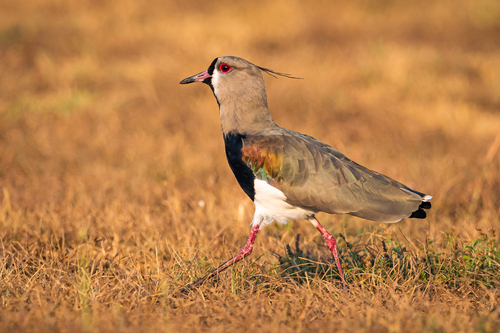
Southern Lapwing
The Southern Lapwing (*Vanellus chilensis*) is a striking and widespread wader found throughout much of South America. Known for its bold black, white, and gray plumage, distinctive red eye-ring, and loud, piercing calls, it is a familiar sight in open grasslands, pastures, and wetlands. It plays an important ecological role as an insectivore, helping to control populations of invertebrates. The Southern Lapwing also holds some cultural significance, often appearing in South American folklore and being a symbol of vigilance and protection of the land.
32-38 cm
Length
70-80 cm
Wingspan
Least Concern
Conservation Status
Distribution
The Southern Lapwing is native to South America, with a range extending from Colombia and Venezuela in the north to southern Argentina and Chile. It has also expanded its range into Central America, reaching Panama and Costa Rica. There are occasional sightings reported in the southern United States (e.g., Florida, Texas), likely representing vagrant individuals.
Lifespan
Up to 15 years in the wild (estimated).
Southern Lapwing's Habitat
Habitat Types
Grasslands, Savannas, Pastures, Wetlands (including marshes and riverbanks), Agricultural fields, Urban parks
Climate Zones
Tropical, Subtropical, Temperate
Adaptations
The Southern Lapwing's long legs allow it to wade in shallow water and navigate tall grasses. Its sharp eyesight helps it spot prey from a distance. The spurs on its wings are used in territorial defense.
Variations
Several subspecies are recognized, differing slightly in plumage and size. For example, *V. c. cayennensis* is found in northern South America, while *V. c. lampronotus* is found in the southern part of the continent.
Appearance
Breeding Plumage
Plumage is generally consistent year-round, with no significant differences between breeding and non-breeding seasons.
Seasonal Feather Changes
None
Sex Based Plumage Differences
Males and females have similar plumage.
Notable Features
Red wattles around the eyes, Black forehead and throat, Gray-brown upperparts, White underparts, Small, sharp spurs on the wings, Black breast band
Diet and Feeding
Primary Foods
Insects, Worms, Crustaceans, Other invertebrates, Occasionally small vertebrates (e.g., lizards)
Foraging Behavior
Southern Lapwings typically forage by walking or running on the ground, pecking at prey they spot visually. They may also probe soft soil or mud with their bills.
Specializations
Their long legs and sharp bills are well-suited for capturing prey in open habitats.
Seasonal Diet Variations
Diet may vary slightly depending on prey availability, with a greater reliance on insects during the warmer months and more worms or other invertebrates during cooler periods.
Behavior
Social Structure
Southern Lapwings are often found in pairs or small groups, especially during the breeding season. Outside of the breeding season, they may form larger flocks.
Communication
Loud, piercing 'keek-keek-keek' calls, Variety of alarm calls, Wing-clapping during territorial displays
Migration
Most populations are resident (non-migratory), although some local movements may occur in response to changes in water availability or food resources.
Territorial or Group Behaviors
Highly territorial during the breeding season, aggressively defending their nesting areas. They are known for their bold defense against predators, including humans, often dive-bombing intruders.
Conservation
Threats
Habitat loss (due to agriculture and urbanization), Pesticide use, Human disturbance
Protection Programs
General wildlife protection laws in many South American countries
Local National Laws
Protected under various national and regional wildlife laws throughout its range.
Population Trend
Stable
Population Estimates
Population estimates are not precisely quantified, but the species is considered common and widespread.
Interesting Facts
They possess sharp spurs on their wings.
These spurs are used in territorial defense and to protect against predators. They are not venomous.
They are known for their aggressive nest defense.
Southern Lapwings will fearlessly attack any perceived threat to their nests or young, including much larger animals and humans.
They are sometimes called 'Tero-Tero' in parts of South America.
This name is onomatopoeic, reflecting their distinctive call.
They are the national bird of Uruguay.
The bird is part of the national coat of arms.
Faqs about Southern Lapwing
Are Southern Lapwings dangerous to humans?
While they can be aggressive when defending their nests, they are not typically dangerous to humans. Their attacks are mostly bluff charges, although they may occasionally make contact with their wing spurs.
What should I do if I find a Southern Lapwing nest?
It's best to keep a safe distance from the nest and avoid disturbing the birds. Observe them from afar and allow them to continue their natural behaviors.
Do Southern Lapwings migrate?
Most populations are resident, meaning they stay in the same general area year-round. However, some local movements may occur in response to environmental conditions.
What do the chicks look like?
Southern Lapwing chicks are precocial, meaning they are covered in down and able to walk and feed themselves shortly after hatching. They are well-camouflaged, with mottled brown and white plumage.
Copyright @ Nature Style Limited. All Rights Reserved.
 English
English